Insect Feeding Damage
Small pits or tiny holes on leaf surfaces
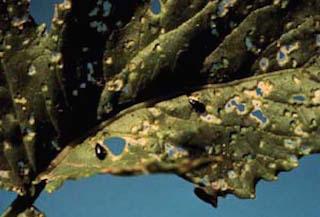
Cause
Flea beetles (various species).
Treatment
Fruit is rarely damaged. Treatment is usually not required. Control by eliminating weeds near field edges, and eliminating overwintering sites by removing crop residue.
Small, circular holes in stems or leaf surfaces, leading to tunneling, and often wilting of stems or fruit
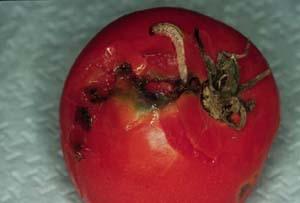
Cause
European corn borer (Ostrinia nubilalis), the larval stage of a moth. In most of Minnesota, only one generation occurs per year.
Treatment
Infected sites are sometimes difficult to spot until infestation is underway. Larva enter stems and fruit through small holes, then begin tunneling throughout the plant. Wilting and broken stems often follow this tunneling activity, and in the case of fruit, feeding damage is often followed by soft rot.
Pesticide treatments are difficult since the larva is only active outside the plant for a few days between egg hatch and tunneling activity--although labelled formulations are commercially available. Watch for flat white egg masses on leaf surfaces, or use black-light insect traps to scout for adult females in mid-June. Pesticides should be applied immediately after egg hatch, or 7 to 10 days after females begin to appear in June.
For additional control remove overwintering sites by eliminating crop residue from corn, pepper, potato, tomato, bean, and beet fields.
Chewing damage on entire leaf surface or fruit, often in midsummer or later
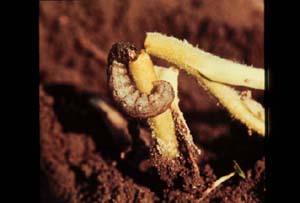 |
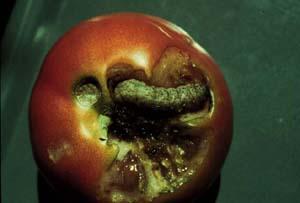 |
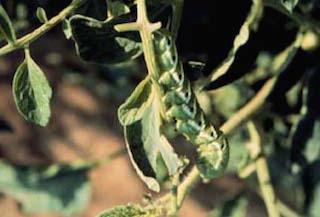 |
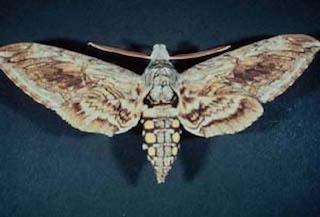 |
Cause
Caterpillars, various species including:
The corn earworm (Helicoverpa zea), up to 2 inches long and appearing in various colors--brown, green, or black with a light colored underside and alternating light and dark lines down the back.
The tomato hornworm (Manduca quinauemaculata), larva of the "sphinx" or "hawk" moth. Larva are pale green with black and white markings and a large black protruding "horn" on the last abdominal segment. Late stage larva can reach 3 1/2 to 4 inches in length.
The black cutworm (Agrotis ipsilon), a dark gray or black caterpillar with a broken yellow stripe down the back. Individuals may be up to 1 1/2 inches in length. Feeding damage is often characterized by seedling plant stems being cut-off at the ground. Black cutworms often curl up when disturbed and usually feed at night so they may not be visible during the day.
Feeding damage of these and other caterpillars is characterized by chewing of leaf or fruit surfaces sometimes accompanied by dark green or black droppings. Individual color patterns of caterpillars can vary, and the green color of many species makes them difficult to spot.
Treatment
Remove caterpillars by hand in small plantings. In large plantings, use approved formulations of Bt. Apply these pesticides when caterpillars are young and small if possible, and when populations exceed 0.5 caterpillars per plant.
Leaf skeletonization or chewing damage on leaf edges in late spring or early summer
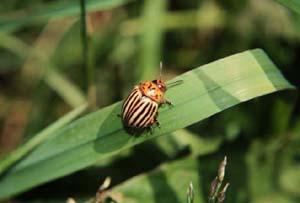 |
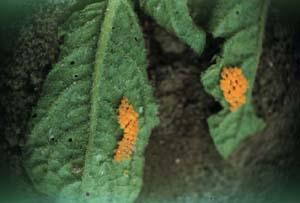 |
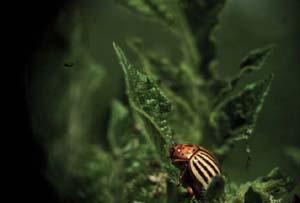 |
Cause
The Colorado potato beetle (Lepitinotarsa decemilineata). Both adult beetles and larva feed on leaves, flowers, and sometimes young fruit. The larva is more destructive than adult beetles.
Adult beetles are about 3/8 of an inch long with tan heads and conspicuous black and yellow-white striped bodies. Larvae are 1/8 to 1/2 inch long with soft, reddish-tan bodies. On either side of the body larva have 2 noticeable rows of black spots.
Yellowish-orange egg masses may also be noticeable on the undersides of leaves in clumps of 20 to 40 eggs.
Adult beetles emerge from underground in June feeding on the upper leaves of young plants and laying eggs. In parts of southern Minnesota a 2nd generation may occur. After eggs hatch larvae emerge and begin feeding. These immature beetles overwinter underground where they pupate before emerging as adults in the spring.
Feeding damage often begins at leaf edges progressing inward resulting in complete defoliation in badly infested fields. Often times leaf blades are consumed while the leaf veins are left intact creating a skeletonized leaf.
Treatment
Control of the Colorado potato beetle is difficult. This insect develops rapid and frequent resistance to pesticides rendering them ineffective. Bt formulations are commercially available for control of this insect.
Row covers may offer some physical protection against infestation, but they may also limit pollination. Other control practices involve frequent crop rotations--avoiding consecutive plantings of tomato, potato, and eggplant year after year.
Colorado potato beetle populations of more than 1 beetle for every 2 plants should be considered a significant action threshold and control action should be taken.
Yellow leaves with a shiny or sticky substance on leaf surfaces
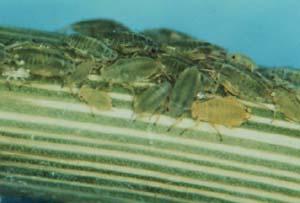 |
 |
Cause
Aphids and whiteflies (various species). These small soft-bodied insects are less than 1/8 inch long and appear in a variety of colors. Using piercing-sucking mouth parts, aphids and whiteflies remove plant sap and often spread disease in the process. Ants are often drawn to their sticky excrement.
Treatment
Fruit is rarely damaged. Treatment is usually not required as many natural predators such as lady beetles exist. However in widespread infestations (more than 50% of all leaves in field infested), action may be necessary. Low toxicity insecticidal soaps and horticultural oils are highly effective.
Spots, Lesions, or Discoloration on Fruit, Stems, or Leaves
Scab-like raised lesions on fruit
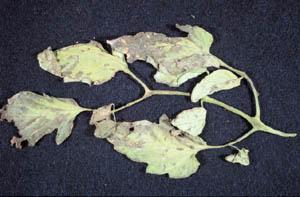 |
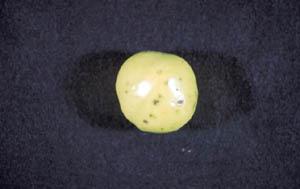 |
Cause
Bacterial leafspot (Xanthomonas campestris), a bacterial disease.
Treatment
This disease is spread by mechanical damage to plants during rainy or wet conditions. Few legal antibiotic treatments are available. To prevent infection avoid damage (such as caused by cultivation) to wet plants. Also rotate crops, avoid consecutive cropping of peppers, tomatoes, eggplant, or potatoes.
Large wounds accompanied by dusty, black spores
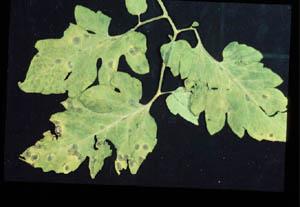
Cause
Early Blight (Alternaria solani), a fungal disease.
Treatment
Plant resistant varieties. Copper-based and other approved fungicides are available.
Dark wet lesions that spread to the entire fruit
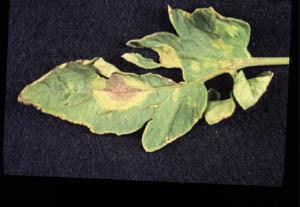 |
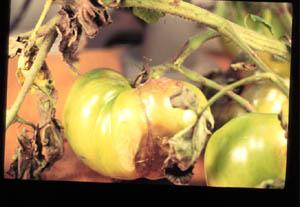 |
Cause
Late Blight (Phytophthora infestans), a fungal disease.
Treatment
This disease is spread during rainy or wet conditions. Space plants to allow for rapid drying. Remove host weeds near fields such as nightshade. Also rotate crops, avoid consecutive cropping of peppers, tomatoes, eggplant, or potatoes.Resistant varieties are not available.
Dry, light-colored lesions on the flower side of the fruit
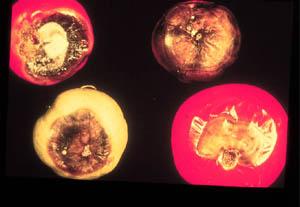
Cause
Blossom End Rot, a condition caused by drought conditions or calcium deficiency.
Treatment
Maintain adequate soil moisture, contact the U of M Soil Test Lab for recommendations, at 612-625-3101
Yellow or brown ring-shaped spots, or misshapen fruit
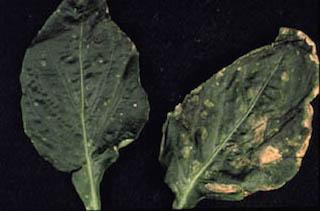 |
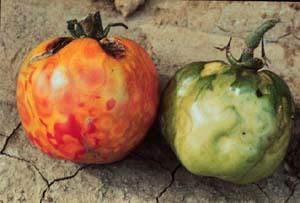 |
Cause
Viruses. May be accompanied by curled or misshapen leaves or fruit. Many viruses infect tomato including Tobacco Mosaic Virus, Tomato Spotted Wilt Virus, Cucumber Mosaic Virus, and many others. All are spread by insects or infected seed.
Treatment
Buy disease-free seed from a reputable source. Plant resistant varieties.
Sunken, circular lesions with target-like rings
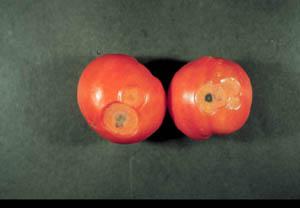
Cause
Anthracnose (Colletotrichum spp.), a fungal disease.
Treatment
Widespread outbreaks are usually not common. Remove infected fruit immediately and do not allow fruit to over-ripen. Stake plants to prevent fruit contact with soil.
Dark brown leaf spots with tan or gray centers, starting on older leaves with uninfected fruit
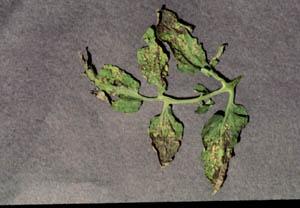
Cause
Septoria leafspot (Septoria lycopersici), a fungal disease.
Treatment
This disease is spread during rainy or wet conditions. Space plants to allow for rapid drying. Use approved fungicides. Remove host weeds near fields such as nightshade. Also rotate crops, avoid consecutive cropping of peppers, tomatoes, eggplant, or potatoes.Resistant varieties are not available.
Gray or brown spots on older leaves with the centers of spots falling out and leaving holes
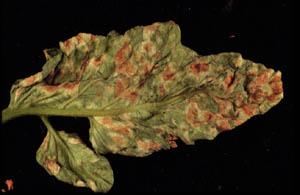 |
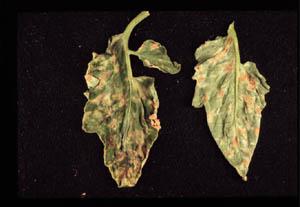 |
Cause
Gray Leaf Spot (Stemphylium solani), a fungal disease.
Treatment
Plant resistant varieties. Copper-based and other approved fungicides are available.
Yellow or brown leaves, often starting at the tips
Cause
Abiotic (non-living) cause. Possible nutrient deficiency.
Treatment
Contact the U of M Soil Test Lab for recommendations, at 612-625-3101